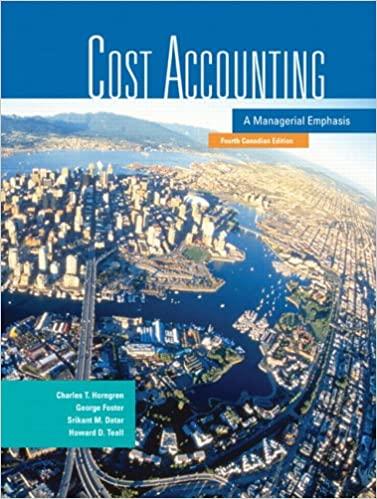Interpretation ofstatements (continuation of2-32). Refer to the preceding problem. Required 1. How would the answer to the
Question:
Interpretation ofstatements (continuation of2-32). Refer to the preceding problem.
Required 1. How would the answer to the preceding problem be modified ifyou were asked for a sched¬
ule of cost of goods manufactured and sold instead of a schedule of cost of goods manufac¬
tured? Be specific.
2. Would the sales manager’s salary (included in marketing, distribution, and customer serv¬
ice costs) be accounted for any differently if the Chan Corporation were a merchandising company instead of a manufacturing company? Using the flow of costs outlined in Exhibit 2-10
(p. 49), describe how the wages of an assembler in the plant would be accounted for in this manufacturing company.
3. Plant supervisory salaries are usually regarded as indirect manufacturing costs. Under what conditions might some of these costs be regarded as direct manufacturing costs?
Give an example.
4. Suppose that both the direct materials used and the plant amortization were related to the manufacture of 1 million units of product. What is the unit cost for the direct materials assigned to those units? What is the unit cost for plant building and equipment amortiza¬
tion? Assume that yearly amortization is computed on a straight-line basis.
5. Assume that the implied cost behaviour patterns in requirement 4 persist. That is, direct materials costs behave as a variable cost and plant amortization behaves as a fixed cost.
Repeat the computations in requirement 4, assuming that the costs are being predicted for the manufacture of 1.5 million units of product. How would the total costs be affected?
6. As a management accountant, explain concisely to the president why the unit costs differed in requirements 4 and 5 2-34 Overtime premium, defining accounting terms. Gwen Benson, Ian Blacklaw, and Eduardo Cabrera are sales representatives for Electronic Manufacturing Inc. (EMI). EMI specializes in low-volume production orders for the research groups of major companies.
Each sales representative receives a base salary plus a bonus based on 20% of the actual profit of each order they sell. Before this year, the bonus was 5% of the revenues of each order they sold. Actual profit in the revised system was defined as actual revenue minus actual manufac¬
turing cost. EMI uses a three-part classification of manufacturing costs—direct materials, direct manufacturing labour, and indirect manufacturing costs. Indirect manufacturing costs are determined as 200% of actual direct manufacturing labour cost.
Benson receives a report on an EMI job for BBC Inc. She is dismayed by the low profit on the BBC job. She prided herself on not discounting the price BBC would pay by convinc¬
ing them ofthe quality of EMI’s work. Benson discussed the issue with Blacklaw and Cabrera.
They share with her details of their most recent jobs. Summary data are as follows:
Customer Sales Representative Westec Blacklaw La Electricidad Cabrera BBC Benson Revenues $504 $984 $576 Direct materials 300 492 324 Direct manuf. labour 48 120 72 Indirect manufacturing 96 240 144 Direct labour hours 2 hours 5 hours 2 hours Benson asks Hans Brunner, EMI’s manufacturing manager, to explain the different labour costs charged on the Westec and BBC jobs, given both used two direct labour hours. She was told the BBC job was done in overtime and that the actual overtime rate ($36) was 50% higher than the $24 per hour straight-time rate. Benson noted that she brought the BBC order to EMI one week ago and that there was no rush-order on the job. In contrast, the Westec order was a
“hot-hot” one with a request it be done by noon the day after the order was received. Brunner said that the “actual cost” he charged to the BBC job was actually paid to the workers on that job.
Required 1. Using both the actual straight-time and overtime rates paid for direct labour, what is the actual profit EMI would report on each ofthe three jobs?
2. Assume that EMI charges each job for direct labour at the $24 straight-time rate (and that the indirect-manufacturing rate of 200% includes an overtime premium). What would be the revised profit EMI would report on each of the three jobs? Comment on any differ¬
ences from requirement 1.
3. Discuss the pros and cons of charging the BBC job the $36 labour rate per hour.
4. Why might EMI adopt the 20% profit incentive instead ofthe prior 5% ofrevenue incentive?
How might EMI define “profit” to reduce possible disagreements with its sales representatives?
Step by Step Answer:

Cost Accounting A Managerial Emphasis
ISBN: 9780131971905
4th Canadian Edition
Authors: Charles T. Horngren, George Foster, Srikant M. Datar, Howard D. Teall





